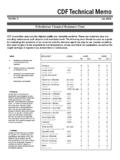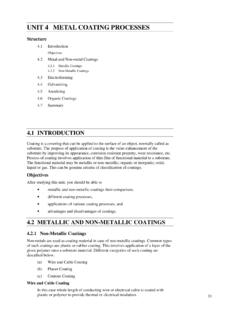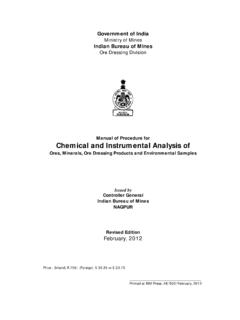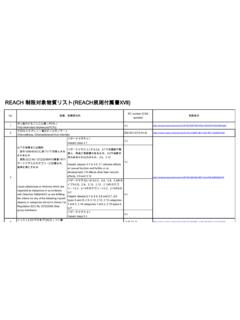Transcription of CDF Technical Memo
1 AcetoneB CB CAcetaldehyde*100%BCBCA cetic Acid*10%AAAAA cetic Acid*60%ABABA cetic Anhydride*CCCCAirAAAAA luminum Chlorideall concAAAAA luminum Fluorideall concAAAAA luminum Sulphateall concAAAAA lumsall typesAAAAA mmonia100% dry gas AAAAA mmonium CarbonateAAAAA mmonium Chloridesat dAAAAA mmonium Fluoridesat dAAAAA mmonium Hydroxide10%AAAAA mmonium Hydroxide28%AAAAA mmonium Nitratesat dAAAAA mmonium Persulphatesat dAAAAA mmonium Sulphatesat dAAAAA mmonium Metaphosphate sat dAAAAA mmonium Sulfidesat dAAAAAmyl Acetate#*100%CCCCAmyl Alcohol#*100%AAAAAmyl Chloride#100%CCCCA niline#*100%ACCBAqua Regia+CCCCA rsenic Acidall concAAAAA romatic Hydrocarbons#*CCCCA scorbic Acid10%AAAAB arium Carbonatesat dAAAAB arium Chloridesat dAAAAB arium HydroxideAAAAB arium Sulphatesat dAAAAB arium Sulphidesat dAAAABeerAAAAB enzene#*CCCCPP oollyyeetthhyylleennee CChheemmiiccaall RReessiissttaannccee CChhaarrttCDF Corporation uses only the highest quality raw materials available.
2 These raw materials have out-standing resistance to both physical and chemical attack. The following chart should be used as a guidefor evaluating the suitability of our products with the chemical agent you plan to use. Special considera-tion must be given to the expected service temperature, stress involved in the application, as well as thelength and type of exposure ( intermittent or continuous).CDF Technical MemoNumber 1 July 2004# Plasticizer. Certain types of chemicals areabsorbed to varying degrees by poly-ethylene causing swelling, weight-gain,softening and some loss of yieldstrength. These plasticizing materialscause no actual chemical degrada-tion of the resin. Several of thesechemicals have a strong plasticizingeffect ( aromatic hydrocarbonsbenzene), whereas others have weakereffects ( gasoline). Certain plasti-cizers are sufficiently volatile that ifthey are removed from contact withthe polyethylene, the part will dry outand return to its original condition withno loss of properties.
3 + are the only group of materi-als capable of chemically degradingpolyethylene. The effects on the poly-ethylene may be gradual even forstrong oxidizers and short-term effectsmay not be measurable. However, ifcontinuous long-term exposure isintended, the chemical effects shouldbe checked AResistant no indication thatserviceability would resistance, dependingon conditions of , not recommendedfor service applications underany not 140 70 140 Benzoic Acidall concAAAAB ismuth Carbonatesat dAAAAB leach Lye10%AAAAB oraxsat dAAAAB oric Acidall concAAAAB oron TrifluorideAAAAB rineAAAAB romine+liquidCCCCB romine Water#sat dCCCCB utanediol*10%AAAAB utanediol*60%AAAAB utanediol*100%AAAAB utter*AAAAn-Butyl Acetate#*100%BCABn-Butyl Alcohol*100%AAAAB utyric Acid#concCCCCC alcium BisulphideAAAAC alcium Carbonatesat dAAAAC alcium Chloratesat dAAAAC alcium Chloridesat dAAAAC alcium HydroxideconcAAAAC alcium Hypochloridebleach solAAAAC alcium Nitrate50%AAAAC alcium Oxidesat dAAAAC alcium SulphateAAAAC amphor Oil#*CCBCC arbon Dioxideall concAAAAC arbon DisulphideCCCCC arbon MonoxideAAAAC arbon Tetrachloride#CCBCC arbonic AcidAAAAC astor 0il*concAAAAC hlorine+100% dry gas BCCCC hlorine
4 Liquid+CCCCC hlorine Water+2% sat d solAAAAC hlorobenzene#*CCCCC hloroform*#CCBCC hlorosulphonic Acid 100%CCCCC hrome Alumsat dAAAAC hromic Acid80%----Chromic Acid50%ABABC hromic Acid10%AAAAC ider*AAAAC itric Acid*sat dAAAAC oconut 0il Alcohols*AAAAC offeeAAAACola Concentrate*AAAAC opper Chloridesat dAAAAC opper Cyanidesat dAAAAC opper Fluoride2%AAAAC opper Nitratesat dAAAAC opper Sulphatesat dAAAACorn 0il*AAAAC ottonseed 0il*AAAAC uprous Chloridesat dAAAAD etergents Synthetic*AAAAD evelopers PhotographicAAAAD extrinsat dAAAAD extrosesat dAAAACODES AResistant no indication thatserviceability would resistance, dependingon conditions of , not recommendedfor service applications underany not available.# Plasticizer. Certain types of chemicals areabsorbed to varying degrees by poly-ethylene causing swelling, weight-gain,softening and some loss of yieldstrength.
5 These plasticizing materialscause no actual chemical degrada-tion of the resin. Several of thesechemicals have a strong plasticizingeffect ( aromatic hydrocarbonsbenzene), whereas others have weakereffects ( gasoline). Certain plasti-cizers are sufficiently volatile that ifthey are removed from contact withthe polyethylene, the part will dry outand return to its original condition withno loss of properties.+ are the only group of materi-als capable of chemically degradingpolyethylene. The effects on the poly-ethylene may be gradual even forstrong oxidizers and short-term effectsmay not be measurable. However, ifcontinuous long-term exposure isintended, the chemical effects shouldbe checked SaltsAAAAD ibutylphthalate*BBBBD ichlorobenzene#*CCCCD iethyl Ketone#*BCBBD iethylene Glycol*AAAAD iglycolic Acid*AAAAD imethylamineCCCCD isodium PhosphateAABAE mulsions.
6 Photographic*AAAAE thyl Acetate#*100%BCBCE thyl Alcohol*100%AAAAE thyl Alcohol*35%AAAAE thyl Benzene#*CCCCE thyl Chloride#CCCCE thyl Ether#CCCCE thylene Chloride#*CCCCE thylene Glycol*AAAAF atty Acids*AAAAF erric Chloridesat dAAAAF erric Nitratesat dAAAAF errous Chloridesat dAAAAF errous SulphateAAAAFish Solubles*AAAAF luoboric AcidAAAAF luosillcic AcidconcABABF luosillcic Acid32%AAAAF ormic Acidall concAAAAF ructosesat dAAAAF ruit Pulp*AAAAF urtural#100%CCBCF urturyl Alcohol#*CCBCG allic Acid*sat dAAAAG asoline#*CCBBG lucoseAAAAG lycerine*AAAAG lycol*AAAAG lycolic Acid*30%AAAAG rape SugarAAAAn-Heptane#*CCBBH exachlorobenzeneAAA-Hexanol Tertiary*AAAAH ydrobromic Acid50%AAAAH ydrochloric Acidall concAAAAH ydrocyanic Acidsat dAAAAH ydrofluoric Acid*60%AAAAH ydrogen100%AAAAH ydrogen Chloridedry gasAAAAH ydrogen Peroxide30%AAAAH ydrogen Peroxide10%AAAAH ydrogen SulphideAAAAH ydroquinoneAAAAH ypochlorous *AAAA lodine+in Kl sol nBCB-Isopropyl Alcohol100%----Lead Acetatesat dAAAALead NitrateAAAAL actic Acid*20%AAAAL inseed Oil*100%BCBCCODES AResistant no indication thatserviceability would resistance, dependingon conditions of , not recommendedfor service applications underany not available.
7 # Plasticizer. Certain types of chemicals areabsorbed to varying degrees by poly-ethylene causing swelling, weight-gain,softening and some loss of yieldstrength. These plasticizing materialscause no actual chemical degrada-tion of the resin. Several of thesechemicals have a strong plasticizingeffect ( aromatic hydrocarbonsbenzene), whereas others have weakereffects ( gasoline). Certain plasti-cizers are sufficiently volatile that ifthey are removed from contact withthe polyethylene, the part will dry outand return to its original condition withno loss of properties.+ are the only group of materi-als capable of chemically degradingpolyethylene. The effects on the poly-ethylene may be gradual even forstrong oxidizers and short-term effectsmay not be measurable. However, ifcontinuous long-term exposure isintended, the chemical effects shouldbe checked Carbonatesat dAAAAM agnesium Chloridesat dAAAAM agnesium Hydroxidesat dAAAAM agnesium Nitratesat dAAAAM agnesium Sulphatesat dAAAAM ercuric Chloride40%AAAAM ercuric Cyanidesat dAAAAM ercuryAAAAM ethyl Alcohol*100%AAAAM ethylethyl Ketone#*100%BCBCM ethylene Chloride#*100%CCBBMilkAAAAM ineral Oils#BCBCM olassesAAAAN aphtha#*BCBCN aphthalene#*CCB- nickel ChlorideconcAAAAN ickel Nitratesat dAAAAN ickel SulphateconcAAAAN icotine*diluteAAAAN itric Acid0-30%AAAAN itric Acid+30-50%ABABN itric Acid+70%ABABN itric Acid+95-98%CCCCN itrobenzene#*100%CCCCn-OctaneAAAAO leic AcidBCBCO xalic Acid*sat dAAAAP erchloroethylene#CCCCP hosphoric Acid95%ABAAP hotographic SolutionsAAAAP lating Solutions*BrassAAAAC admiumAAAAC hromiumAAAAC opperAAAAGoldAAAAI ndiumAAAALeadAAAAN ickelAAAAR hodiumAAAAS
8 LiverAAAATinAAAAZincAAAAP otassium Bicarbonatesat dAAAAP otassium Bromidesat dAAAAP otassium Bromate10%AAAAP otassium CarbonateAAAAP otassium Chloratesat dAAAAP otassium Chloridesat dAAAAP otassium Chromate40%AAAAP otassium Cyanidesat dAAAAP otassium Dichromate40%AAAAP otassium Ferri/FerroCyanidesat dAAAAP otassium FluorideAAAAP otassium HydroxideconcAAAAP otassium Nitratesat dAAAAP otassium Perboratesat dAAAACODES AResistant no indication thatserviceability would resistance, dependingon conditions of , not recommendedfor service applications underany not available.# Plasticizer. Certain types of chemicals areabsorbed to varying degrees by poly-ethylene causing swelling, weight-gain,softening and some loss of yieldstrength. These plasticizing materialscause no actual chemical degrada-tion of the resin. Several of thesechemicals have a strong plasticizingeffect ( aromatic hydrocarbonsbenzene), whereas others have weakereffects ( gasoline).
9 Certain plasti-cizers are sufficiently volatile that ifthey are removed from contact withthe polyethylene, the part will dry outand return to its original condition withno loss of properties.+ are the only group of materi-als capable of chemically degradingpolyethylene. The effects on the poly-ethylene may be gradual even forstrong oxidizers and short-term effectsmay not be measurable. However, ifcontinuous long-term exposure isintended, the chemical effects shouldbe checked Perchlorate10%AAAAP otassium Permanganate 20%AAAAP otassium Persulphatesat dAAAAP otassium SulphateconcAAAAP otassium SulphideconcAAAAP otassium SulphiteconcAAAAP ropargyl Alcohol*AAAAn-Propyl Alcohol*AAAAP ropylene Dichloride#*100%CCC-Propylene GlyCol*AAAAP yridine*A-A-Resorcinolsat dAAAAS alicylic Acidsat dAAAASea WaterAAAAS elenic AcidAAAAS hortening*AAAAS liver Nitrate Sol nAAAASoap Solutions*any concAAAAS odium Acetatesat dAAAAS odium Benzoate35%AAAAS odium Biscarbonate sat dAAAAS odium Bisulphatesat dAAAAS odium Bisulphite sat dAAAAS odium BorateAAAAS odium Bromide diluteAAAAS odium Carbonate concAAAAS odium Chloratesat dAAAAS odium Chloride sat dAAAAS odium CyanideAAAAS odium Dichromate sat dAAAAS odium Ferri/FerroCyanidesat dAAAAS odium Fluoridesat dAAAAS odium
10 HydroxideconcAAAAS odium HypochloriteAAAAS odium NitrateAAAAS odium SulphateAAAAS odium Sulphidesat dAAAAS odium Sulphitesat dAAAAS tannic Chloridesat dAAAAS tannous Chloridesat dAAAAS tarch Solution*sat dAAAAS tearic Acid*100%AAAAS ulphuric Acid0-50%AAAAS ulphuric Acid+70%ABABS ulphuric Acid+80%ACACS ulphuric Acid+96%BCBCS ulphuric Acid+98-concBCBCS ulphuric Acid+fumingCCCCS ulphurous AcidAAAAT allow#ABA-Tannic Acid*sat dAAAAT artaric AcidAAAAT etrolydrofuran#*CCBCT itanium Tetrochloridesat dCCC-Toluene#*CCBBT richloroethylene#*CCCCT riethylene Glycol*AAAAT risodium Phosphatesat dAAAA# Plasticizer. Certain types of chemicals areabsorbed to varying degrees by poly-ethylene causing swelling, weight-gain,softening and some loss of yieldstrength. These plasticizing materialscause no actual chemical degrada-tion of the resin. Several of thesechemicals have a strong plasticizingeffect ( aromatic hydrocarbonsbenzene), whereas others have weakereffects ( gasoline).



